Related Research Articles

Puerto Rico, officially the Commonwealth of Puerto Rico, is a Caribbean island, Commonwealth, and unincorporated territory of the United States. It is located in the northeast Caribbean Sea, approximately 1,000 miles (1,600 km) southeast of Miami, Florida, between the Dominican Republic and the U.S. Virgin Islands, and includes the eponymous main island and several smaller islands, such as Mona, Culebra, and Vieques. With roughly 3.2 million residents, it is divided into 78 municipalities, of which the most populous is the capital municipality of San Juan. Spanish and English are the official languages of the executive branch of government, though Spanish predominates.
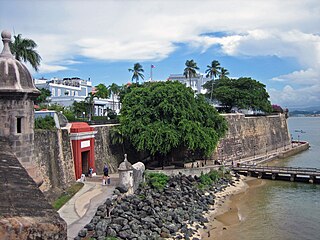
San Juan is the capital city and most populous municipality in the Commonwealth of Puerto Rico, an unincorporated territory of the United States. As of the 2020 census, it is the 57th-largest city under the jurisdiction of the United States, with a population of 342,259. San Juan was founded by Spanish colonists in 1521, who called it Ciudad de Puerto Rico.

Puerto Ricans, most commonly known as Boricuas, and also referred to as Borinqueños,Borincanos, or Puertorros, are the people of Puerto Rico, the inhabitants and citizens of the Commonwealth of Puerto Rico and their descendants, including those in mainland United States.
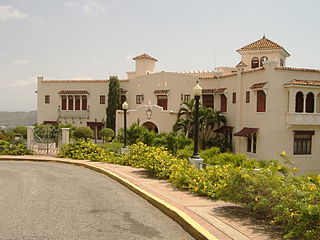
Ponce is a city and a municipality on the southern coast of Puerto Rico. The most populated city outside the San Juan metropolitan area, was founded on August 12, 1692 and is named after Juan Ponce de León y Loayza, the great-grandson of Spanish conquistador Juan Ponce de León. Ponce is often referred to as La Perla del Sur, La Ciudad Señorial, and La Ciudad de las Quenepas.

Bayamón is a city, municipality of Puerto Rico and suburb of San Juan located in the northern coastal valley, north of Aguas Buenas and Comerío; south of Toa Baja and Cataño; west of Guaynabo; and east of Toa Alta and Naranjito. Bayamón is spread over 11 barrios and Bayamón Pueblo. It is part of the San Juan-Caguas-Guaynabo Metropolitan Statistical Area and the second most populous municipality in both the metropolitan area and Puerto Rico.

The University of Puerto Rico is the main public university system in the U.S. Commonwealth of Puerto Rico. It is a government-owned corporation with 11 campuses and approximately 44,200 students and approximately 4,450 faculty members. UPR has the largest and most diverse academic offerings in the commonwealth, with 472 academic programs of which 32 lead to a doctorate.
The municipalities of Puerto Rico are the second-level administrative divisions in the Commonwealth of Puerto Rico. There are 78 such administrative divisions covering all 78 incorporated towns and cities. Each municipality is led by a mayor and divided into barrios, third-level administrative divisions, though the latter are not vested with any political authority. Every municipality is governed as stated by the Autonomous Municipalities Act of 1991, which establishes that every municipality must have an elected strong mayor with a municipal legislature as the form of government. Each legislature must be unicameral, with the number of members related to adequate representation of the total population of the municipality. In contrast to other jurisdictions, both the mayors and the municipal legislators are elected on the same date and for the same term of four years in office.

Guaynabo is a city, suburb of San Juan and municipality in the northern part of Puerto Rico, located in the northern coast of the island, north of Aguas Buenas, south of Cataño, east of Bayamón, and west of San Juan. Guaynabo is spread over 9 barrios and Guaynabo Pueblo. Guaynabo is considered, along with its neighbors – San Juan and the municipalities of Bayamón, Carolina, Cataño, Trujillo Alto, and Toa Baja – to be part of the San Juan metropolitan area. It is also part of the larger San Juan-Caguas-Guaynabo Metropolitan Statistical Area,.

The following is an alphabetical list of articles related to the Commonwealth of Puerto Rico.
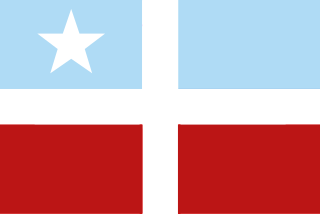
Throughout the history of Puerto Rico, its inhabitants have initiated several movements to gain independence for the island, first from the Spanish Empire between 1493 and 1898 and since then from the United States. Today, the movement is most commonly represented by the flag of the Grito de Lares(Cry of Lares) revolt of 1868.
The Puerto Rico national football team represents Puerto Rico in men's international football, and are governed by the Federación Puertorriqueña de Fútbol (FPF). The team's nickname is El Huracán Azul meaning The Blue Hurricane. They are members of the Caribbean Football Union, and part of CONCACAF. The team has never qualified for the FIFA World Cup or the CONCACAF Gold Cup.
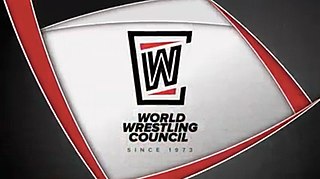
The World Wrestling Council (WWC), is a professional wrestling promotion based in Puerto Rico. It was originally established as Capitol Sports Promotions in 1973 by Carlos Colón, Victor Jovica, and Gorilla Monsoon. By the mid-1990s, the promotion had changed its name to the World Wrestling Council. It was a member of the National Wrestling Alliance until 1988. WWC is among the oldest professional wrestling promotions in the world and one of only eight in the entire world to reach its 50th anniversary in continuous operation.
This is a list of properties and historic districts that are listed on the National Register of Historic Places (NRHP) in Puerto Rico. There are 371 listings in Puerto Rico, with one or more listing in each of Puerto Rico's 78 municipalities.

The Puerto Rican Football Federation is the governing body of association football in Puerto Rico. It was founded in 1940 and became affiliated to FIFA in 1960, one of the last to do so in the Western Hemisphere. It governs over all football on the island, including the Puerto Rico national football team, the amateur Liga Nacional de Fútbol de Puerto Rico, the scheduled Liga Profesional de Fútbol de Puerto Rico, as well as the Puerto Rico FC who played in the North American Soccer League.

The history of Puerto Rico began with the settlement of the Ortoiroid people before 430 BC. At the time of Christopher Columbus's arrival in the New World in 1493, the dominant indigenous culture was that of the Taínos. The Taíno people's numbers went dangerously low during the later half of the 16th century because of new infectious diseases carried by Europeans, exploitation by Spanish settlers, and warfare.
The barrios of Puerto Rico are the primary legal divisions of the seventy-eight municipalities of Puerto Rico. Puerto Rico's 78 municipios are divided into geographical sections called barrios and, as of 2010, there were 902 of them. In the US Census a barrio sometimes includes a division called a comunidad or subbarrio. In Puerto Rico, barrios are composed of sectors. The types of sectors (sectores) may vary, from normally sector to urbanización to reparto to barriada to residencial, among others.

The flag of Puerto Rico represents Puerto Rico and its people. It consists of five equal horizontal stripes, alternating from red to white, with a blue equilateral triangle based on the hoist side bearing a large, sharp, upright, five-pointed white star in the center. The white star stands for the island, the three sides of the triangle for the three branches of the government, the blue for the sky and coastal waters, the red for the blood shed by warriors, and the white for liberty, victory, and peace. The flag is popularly known as the Monoestrellada (Monostarred), meaning having one star, a single star, or a lone star. It is in the Stars and Stripes flag family.
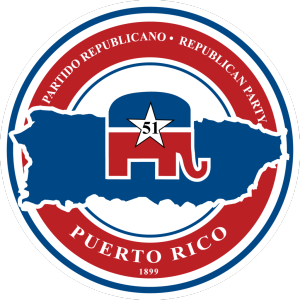
The Republican Party of Puerto Rico is the local affiliate of the national United States Republican Party in Puerto Rico. The affiliation started in 1903. The party does not participate in the November elections mandated by the Constitution of Puerto Rico for local registered political parties because it is not a registered party in Puerto Rico for local electoral purposes. Instead, the party holds its own elections to select the Puerto Rico delegates to the Republican National Convention and holds presidential primaries on the last Sunday of February.

The COVID-19 pandemic in Puerto Rico was an ongoing viral pandemic of coronavirus disease 2019 (COVID-19), a novel infectious disease caused by severe acute respiratory syndrome coronavirus 2 (SARS-CoV-2). It is part of the ongoing COVID-19 pandemic.
References
- ↑ http://www.camaraderepresentantes.org Archived 2013-07-24 at the Wayback Machine and Boschetti Géigel, Giovanni, Miembros de la Cámara de Representantes de Puerto Rico (1900-presente), 2011.